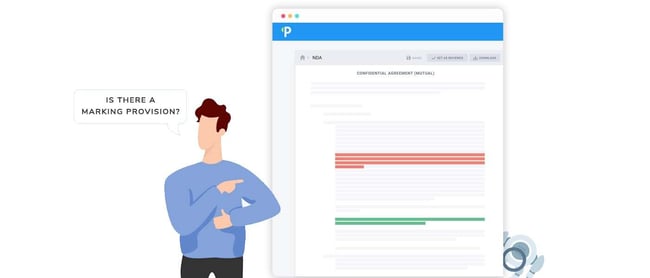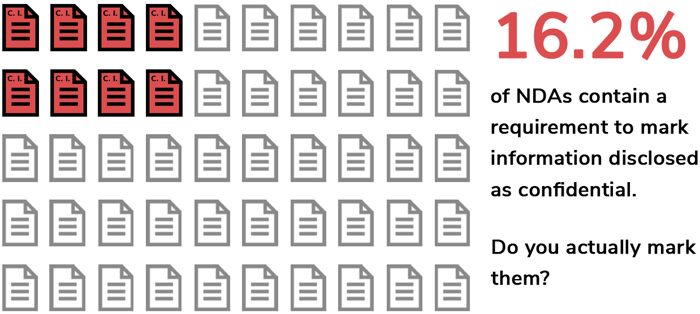Signing an NDA? Look out for unnecessary marking provisions
A non-disclosure agreement (NDA) is an agreement designed to protect you against the risks of unauthorised disclosures when disclosing sensitive information during discussions with another party. A key question you should consider is how the NDA defines the term “confidential information”.

Getting the most critical definitions right
While it is tempting to reuse previous definitions, you could risk leaving out the specific information you intended to protect. In the worst case, the definition may be too broad or vague that it ends up challenged in court and invalidated.
Given the importance of this definition, you’ll want to get it right. In this article, we discuss the issues surrounding one particular drafting of the definition of “confidential information”. This definition requires that (a) information disclosed be marked explicitly as confidential, and (b) information disclosed orally be reduced to writing and then marked as confidential.
Marking provisions: more problematic than you may realise
From a random sample of 2,000 NDAs reviewed by our system, we found that 16.2% of NDAs contained a requirement to mark. Approximately a third of these clauses, representing 5.3% of the total, contained a further requirement for information disclosed orally to be reduced to writing and marked. (A sample of a marking provision can be found here.)

These requirements present various issues if you are the disclosing party. To begin with, they are burdensome and rarely complied with in reality. More significantly, they create unnecessary risks for your organisation. Failing to follow the marking procedures could result in the information not being protected under the NDA since it would fall outside the definition of “confidential information”.
Surely it doesn’t matter: we always ignore it anyway?
This risk materialised in Convolve, Inc. And Massachusetts Institute of Technology v. Compaq Computer Corporation and Seagate Technology, LLC Appeal № 2012–1074 (Fed. Cir. Jul. 2, 2013) (“Convolve”). The NDA in Convolve required that to trigger either party’s obligations, the disclosed information must be
- Marked as confidential at the time of disclosure; or
- Unmarked, but treated as confidential at the time of disclosure, and later designated confidential in a written memorandum summarising and identifying the confidential information.
The dispute related to information Convolve shared with Compaq through two presentations. Convolve had sent copies of the presentation slides and a letter discussing the demonstration to Compaq. However, Convolve did not state in writing that the disclosures during those meetings were confidential.
The district court found that Convolve did not send the confirmatory memorandum as required under the NDA and granted Seagate’s motion for summary judgment. On appeal, Convolve asserted that the court improperly granted summary judgment. Convolve argued that the parties, through their course of conduct, adopted a broad construction of the NDA or waived the specific requirement for designating matters as confidential.
The appellate court referred to California case law that requires courts to give effect to the mutual intention of the contracting parties at the time the contract was formed. It reinforced that the intent is ascertained solely from the written contract if possible. The court considered the parties’ intent and the specific language of the clause and upheld the lower court’s findings. The appellate court also rejected Convolve’s assertion that “the parties understood that all oral and visual disclosures were under the purview of the NDA absent a written follow-up memorandum” since this was contrary to the terms of the NDA and would render the clause “a dead letter”.
Key takeaways for you
1. Do not ignore the marking provisions — what you can’t comply with, you should delete.
Disclosing parties should not ignore marking requirements. The argument that parties understand the confidential nature of the disclosures is not a strong one. Neither is the argument that parties waived the requirement to mark by their conduct. Convolve illustrates that it is an uphill task to convince a court to ignore the plain wording of the NDA.
2. Consider being specific about the information that is confidential instead.
Arguably a better approach may be to explicitly define what types of information should be considered confidential based on the actual information you intend to share. Additionally, you may also wish to include a catch-all for information that a reasonable person ought to have known is confidential. We will discuss this approach in a subsequent post.
3. If you agree to a marking provision, set up proper internal controls.
If your NDA requires you to explicitly mark information as confidential, take this requirement seriously. Consider how you can practically implement this requirement in your business. For example, you may consider tasking an employee to double-check all information for appropriate confidential markings before it is sent out. The same employee could follow up after all meetings on the written summaries if required.
Pro Tip: If your business units are questioning why you are “being difficult” or pushing back on the marking provision, consider making them responsible for the ongoing administrative burden of making sure everything is marked or reduced to summaries. We find that this usually helps them understand your position very quickly.)

.jpg?width=630&name=Playbook%20Example%20(desktop).jpg)
